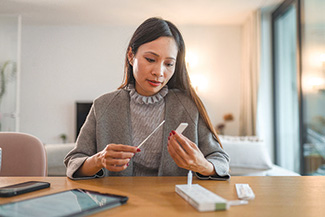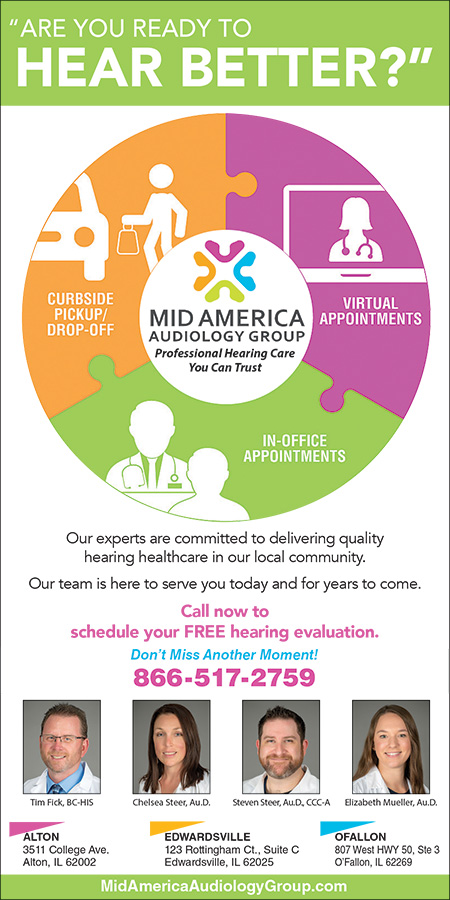No at-home testing for the flu yet
 Most of us are used to a certain routine by now for when we feel sick. If we feel a little feverish, or start coughing, we reach for an at-home testing kit that tells us, with a quick nasal swab and after 15 minutes, if we have COVID-19. The tests are easy to use, and for now, paid for by insurance if you’ve got it. If you don’t have insurance, you can still get the kits for free from some community health centers.
Most of us are used to a certain routine by now for when we feel sick. If we feel a little feverish, or start coughing, we reach for an at-home testing kit that tells us, with a quick nasal swab and after 15 minutes, if we have COVID-19. The tests are easy to use, and for now, paid for by insurance if you’ve got it. If you don’t have insurance, you can still get the kits for free from some community health centers.
If the test shows that you’re positive, you know to stay home and mask up, and ask your doctor about taking antiviral medications that can minimize the symptoms and keep you from getting seriously ill. If you’re a parent and testing your kids, the kits can signal when to keep them at home from school.
WHY NO FLU OR RSV TEST?
So why don’t we have the same self-tests for other common illnesses that spread during the colder months — such as flu and RSV? Each year flu leads to between 300,000 and 800,000 hospitalizations in the U.S., while RSV sends up to 80,000 young children under five years old to the hospital annually.
 While convenient, the medical community and the Food and Drug Administration (FDA) up to now weren’t convinced that people could reliably test themselves at home for things like flu. Decades earlier, it was the same issue with home pregnancy test kits. Ultimately, regulators decided that the level of uncertainty was an acceptable tradeoff for arming women with knowledge about their pregnancy status and over-the-counter tests became available in 1978.
While convenient, the medical community and the Food and Drug Administration (FDA) up to now weren’t convinced that people could reliably test themselves at home for things like flu. Decades earlier, it was the same issue with home pregnancy test kits. Ultimately, regulators decided that the level of uncertainty was an acceptable tradeoff for arming women with knowledge about their pregnancy status and over-the-counter tests became available in 1978.
With similar reasoning, and this time driven by the urgent need during the pandemic to limit the spread of SARS-CoV-2, the FDA authorized the first at-home rapid tests for COVID-19 in spring 2020. Millions of people have since tested themselves or their children, without a medical professional, effectively and responsibly.
Studies conducted on at-home COVID-19 tests showed that people don’t need a medical degree to insert a swab up their nose, swirl it around, and then insert the swab in a pre-made solution and read the resulting lines.
In fact, that technology is essentially the same one that doctors and nurses use in doctors’ offices, emergency rooms and health centers to test for influenza, RSV, and strep. The reason they don’t yet has to do with a number of factors, from cultural bias to the economics of the flu-testing market. The medical community has historically been reluctant to entrust self-tests in the hands of the public.
IMPORTANT TO KNOW WHICH
To date, another reason at-home tests for viruses like influenza haven’t filled pharmacy shelves has been the relatively low demand for them. Most doctors don’t order flu tests for every patient who complains of fever and fatigue during flu season. They make an educated guess based on their patients’ symptoms that with influenza viruses circulating widely during the winter months, those people most likely have the flu — and most treatments, such as Tamiflu, are relatively safe but need to be started as soon as possible after symptoms appear in order to be effective. Most people with flu-like symptoms would assume they have the flu and wouldn’t feel the need to test themselves to confirm that.
But COVID-19 changed that. Since COVID-19 causes similar symptoms to flu of fever, muscle aches and fatigue, doctors can no longer safely assume their patients are infected with influenza. Now, it’s important to distinguish the two infections because they have different antiviral treatments. Having self-tests for influenza as well as SARS-CoV-2 would help to differentiate them and get people started on the right medications for their respective infections more quickly.



Leave a Reply